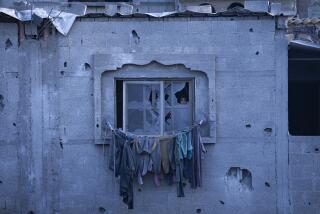Documentary : Remnants of a Battle : One recent violent chapter in the revolt being waged in the Indian state of Kashmir proved that nothing is absolute except death. Officials, rebels, victims all have a different story to tell.
HANGALBUCH, India — As news goes these days in Kashmir, where automatic-weapons fire echoes in the streets and bullet-riddled corpses wash down the rivers, the recent shooting of nine men and women by rampaging Indian troops here barely merited a mention in the local press.
That seemed reason enough to find out what had happened.
Wars are rarely simple. Here, Hindu-dominated India is trying to crush a 4-year-old rebellion in its only Muslim-majority state by secessionist guerrillas seeking either independence from India or accession to neighboring Pakistan, a Muslim state. Thousands of civilians have been killed and no end is in sight.
Like all wars, honest men fight on both sides. Atrocities are committed on both sides. And Orwellian double talk is used on both sides. One nation’s terrorist is another’s freedom fighter; one army’s victory is another’s massacre.
Officials give one version of a battle. Insurgents give another. Victims yet a third. And somewhere is the truth. Only death is absolute.
*
After denouncing the guerrillas for bombing bridges, burning schools and killing his troops, for example, the silver-haired chief of the feared Indian security forces spoke in the next breath as a teacher might chide a truant teen-ager. The militants are “misguided youths,” he said, who were “led astray.”
His own troops “have to be courteous.” Then he paused before adding, “However, at times, mistakes have been committed.” It was the closest he came to conceding the growing criticism by human rights groups of hundreds of cases of rape, torture and summary executions by Indian soldiers.
Earlier, the commander in chief of the most popular militant group, the Jammu and Kashmir Liberation Front, told me the deaths of thousands of his followers were justified “because now you, the foreign press, have come.” I didn’t like that idea.
The JKLF leader, one of India’s most wanted men, also pledged to “fight to the last Kashmiri.” I said I thought the point of war is to make the enemy fight to his last man.
Perhaps a firsthand look would help me better understand.
*
Hangalbuch is 50 miles south of Srinagar, the weary war-torn capital, a three-hour, bone-jarring drive eased by Vermont-like views of rushing white streams, green poplar-dotted mountains and lush apple orchards.
The village has about 400 families, mostly farmers and all Muslim. A cool breeze blew down dusty alleys between the solid, mud-brick homes.
Villagers rushed out to greet us, reporters from Los Angeles, London and Melbourne, Australia, when we arrived four days after the shooting. We were, they said, the first journalists to ever visit Hangalbuch.
The village, it turned out, is a stronghold for the insurgents, especially pro-Pakistan fundamentalists from the Hezb-ul Mujahidin.
On July 21, an antipersonnel mine exploded outside the village, killing one soldier. It was his platoon that came calling at 5 a.m. on July 30.
“After the mine, we received threats from the army,” explained Asadullah Ganai, 70, a local farmer and village leader. “They said, ‘We will teach you a lesson.’ ”
“They did not come as soldiers for a crackdown,” he said angrily. “They came as murderers.”
Ganai rested on a small, shaded platform in the corner of a dirt courtyard. Both his forearms were in splints, and his head and legs were bandaged. His chest, arms and face were literally covered with black and blue welts.
*
“On Friday last my sons and I were in the mosque to offer our prayers,” he said. “Suddenly about 14 soldiers appeared and called us out. I peeked out from the mosque. I asked, ‘Is there going to be a search? I can make an announcement.’ They shouted abuse at me.”
When he locked the door, one of the soldiers threw a rock through the mosque window. Ganai went outside.
“I don’t know what happened,” he said. “They began beating me with sticks. So my sons came out and said, ‘Why are you beating him? He is not a militant.’ They began beating them. They began molesting both of my daughters. My wife, she was dragged and tied to a tree with a rope.”
“My two sons got infuriated. They held the army men and tried to take the sticks. I told them, ‘Don’t do it. They will kill you.’ In the scuffle, a soldier’s rifle fell to the ground. Another soldier picked it up, but they accused my second son of snatching it. He ran away.
“That’s when the army opened fire.”
Three people were killed on the spot. Four more were shot to death on the outskirts of the village. Ganai’s two sons were beaten and arrested. That afternoon, 16-year-old Fahmeeda Ahmed was shot in the head as she tried to rally her neighbors against the army.
“We were asleep and they came and pulled out our bedding,” said her brother, Gulzar. “She thought they were going to rape her. She tried to save her honor.”
Suddenly shouts rang out.
We walked out to the road and were stunned to see about 20 Indian commandos securing positions across a small bridge. Most of the soldiers were Sikhs, big, burly, bearded men with neat black turbans. Several had tied black scarves across their faces as masks.
They crouched with assault rifles behind rocks, trees and rubble. One set up a light machine gun on a tripod. They said nothing.
*
Villagers said they were the same soldiers who had done the killing. Terrified, they pleaded with us not to leave.
The commander of the troops at first refused to meet us. We could see him radioing for instructions. After an hourlong standoff, he finally came out. He and the other officers had removed their name tags and brigade insignia. He was tall and bald and had three rows of ribbons and an easy smile.
“We have come to release the two men arrested on a guarantee that these chaps will not engage in militant activities,” the commander said.
He refused to give his name, or tell what had happened during the shooting other than to say a pistol was confiscated.
Eventually, Ganai’s sons, 24-year-old Bashir Ahmed and 35-year-old Ghulam Nabi, were led barefoot down the rocky path. Ghulam was badly bruised, with stitches in his head and a bloody bandage on his fingers. Bashir appeared swollen and dirty.
Their father kissed their heads, and they kissed his feet.
Although villagers insisted the two men had been horribly tortured, they denied it. “They treated us nice,” said Bashir.
The commander made an impromptu speech in the crowded courtyard, saying Ganai had agreed the village wouldn’t shoot soldiers, use land mines or help harbor militants.
“The army does not want to kill civilians,” the commander said. “We are not barbarians.”
Candy was tossed at the mute crowd. “It’s all a drama,” one officer said with a laugh.
Would the soldiers have released Ganai’s two sons if we weren’t there? Probably. Both men said they were not tortured.
Would they have roughed up more villagers in the process? Possibly. In previous visits, villagers say the troops stole chickens and money.
Will the village continue to shelter militants? Probably. It’s hard to say no to a man with a gun, and anyway, villagers clearly support the revolt.
*
Shortly after the commandos finally drove away, hundreds of people emerged from their homes to chant pro-Pakistan and anti-Indian slogans. Old men in Muslim prayer caps shouted, women in black veils and long scarves wailed, children cried and dogs barked.
As our car inched through the mob, a bearded guerrilla with a broad grin and a Kalashnikov jumped in the front seat. Our guide got him out, but then another militant came to the window. He said his code name was “Zaid.”
“We know we are very small, and India is a very big superpower,” he shouted above the crowd’s roar. “But we will continue our struggle. So you can come back.”
More to Read
Sign up for Essential California
The most important California stories and recommendations in your inbox every morning.
You may occasionally receive promotional content from the Los Angeles Times.











